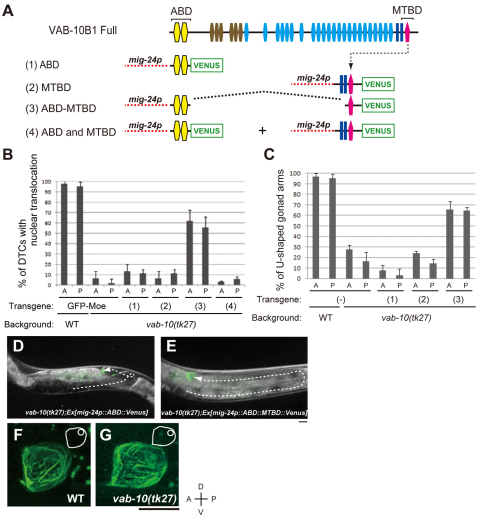Fig. 6.
Rescue experiments with vab-10(tk27) using deletion constructs of VAB-10B1. (A) Schematic diagrams of constructs used in rescue experiments. Transgenic vab-10(tk27) worms carrying extrachromosomal arrays containing (1) mig-24p::ABD::Venus, (2) mig-24p::MTBD::Venus, (3) mig-24p::ABD-MTBD::Venus and (4) both mig-24p::ABD::Venus and mig-24p::MTBD::Venus were generated. (B) The percentage of DTCs that underwent nuclear translocation at the first turn in various transgenic worm strains is shown. The numbers in parentheses correspond to those for the constructs in A. Anterior (A) and posterior (P) DTCs were scored independently. The data are shown as the mean±s.d. (n=45 for each experiment). (C) The percentage of anterior and posterior gonad arms that adopted the U-shaped morphology. The numbers in parentheses correspond to those of the constructs in A. The data are shown as the mean±s.d. (n=45 for each experiment). (D,E) Representative animals of vab-10(tk27); Ex[mig-24p::ABD::Venus] (D) and vab-10(tk27); Ex[mig-24p::ABD-MTBD::Venus] (rescued) (E). The deduced trajectories of DTCs are shown by broken arrows. (F,G) Z-stack confocal images (0.5 μm intervals) of ABD-MTBD-Venus in the wild type (F) and in vab-10(tk27) animals (G). DTCs that had undergone nuclear translocation are shown. The DTCs and their nuclei are illustrated schematically with white lines in each image. Anterior is leftwards and dorsal is upwards. Scale bars: 10 μm.

